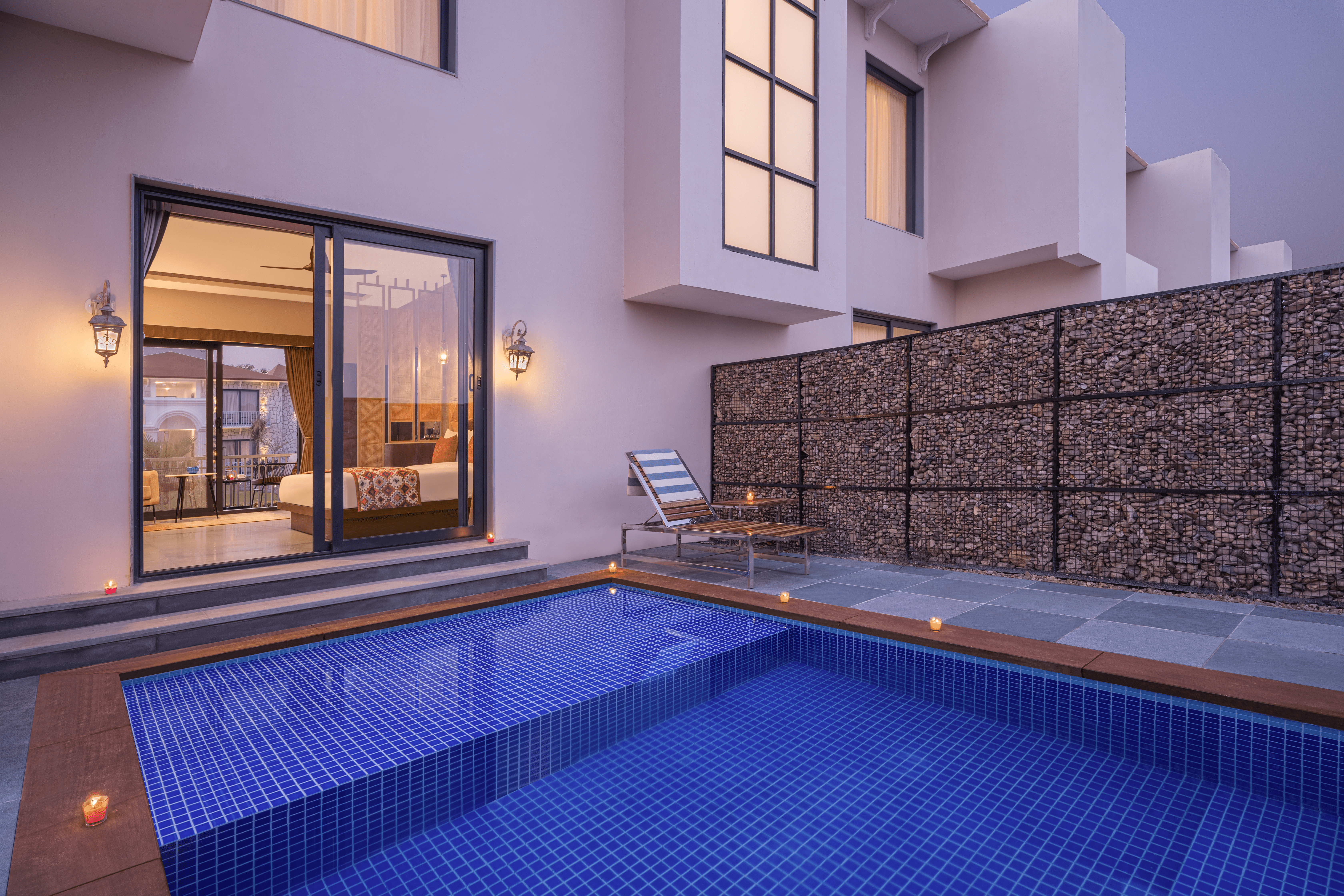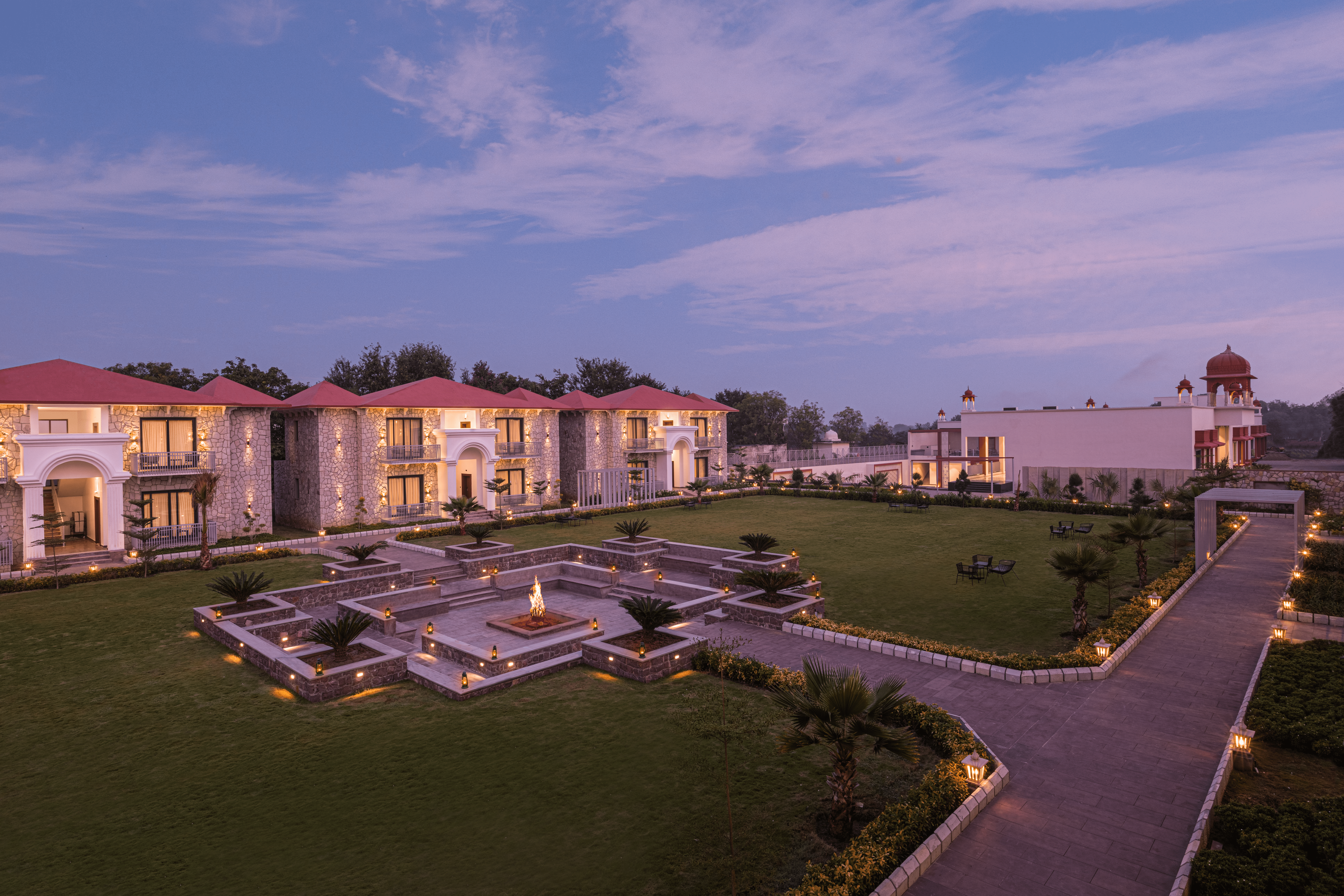Every wall and window at Bookmark Jogi Mahal mirrors the soul of Ranthambore in quiet conversation

We arrived at Bookmark Jogi Mahal, Ranthambore, where the wilderness begins to whisper before you even step into the lobby. The property, envisioned by Ashish Vohra, Onora Hospitality’s Founder & CEO, carries a sense of purposeful design—architecture that merges quietly into its surroundings, with stone, wood, and light used not for grandeur but for dialogue with nature. Every archway opens into a frame of Ranthambore’s wild green, and every corridor hums with the spirit of stillness.
What caught my attention almost immediately were the hand-painted walls and murals — beautiful, detailed artworks that seemed to tell the story of Ranthambore itself. I found myself lingering over each one: the iconic Jogi Mahal framed in earthy tones behind the Reception desk, and as I moved ahead, a complete wall painting dominated by a tiger emerging through painted jungle foliage, and the sprawling branches of a banyan tree reaching across the wall. It felt as though the wilderness had quietly followed me indoors.
What strikes me about Vohra’s approach is the restraint in luxury—spaces here feel soulful rather than styled, allowing the natural drama of Ranthambore’s landscape to take centre stage. His vision for Bookmark has always been about crafting sanctuaries of experience rather than destinations of excess, and Jogi Mahal, with its 40 rooms, including 19 luxury rooms with heated plunge pools, is perhaps his most poetic expression of that ethos.
The perfect dip: A heated plunge pool in the wild
The villas, elegantly and deeply comforting, feel like extensions of the forest itself. Mornings begin with the chirrup of treepies and a slow wash of sunlight through sheer curtains. My luxury villa with a private plunge pool at Bookmark Jogi Mahal felt like a sanctuary woven in Rajasthani warmth. Located on the ground floor of a beautifully designed villa, the space—about 550 to 650 square feet—was generous yet intimate, every detail reflecting the region’s heritage. The soft glow of warm wooden tones and the quiet elegance of the décor created an atmosphere that felt both timeless and deeply personal.

There was space to breathe here. Some afternoons, I sank into the lounger with a book, the world outside hushed except for birdsong. Through glass doors, a private sit-out opened into the green, perfect for morning tea or quiet moments when the jungle’s rhythm felt almost tangible.
But it was the heated temperature-controlled plunge pool, regulated at around 30 °C.that truly defined the experience. It was the perfect touch: Set at just the right temperature, it became my favourite ritual—slipping into the water after a safari, watching dusk fall with a cocktail in hand, the sounds of the forest wrapping around me. Whether it was a quick dip under the afternoon sun or a slow, moonlit soak, the pool felt like indulgence made personal as the night sounds of the jungle drifted across the water.
The open shower area added another layer of charm—bathing under the sky was an experience in itself—while the modern shower cubicle inside offered comfort when I wanted quiet privacy. Every corner of the room seemed designed for ease and reflection, blurring the line between wilderness and luxury.
Outdoor dining under a canopy of stars
That evening, outdoor dining under a canopy of stars followed a session of star-gazing and constellation-mapping. The architecture of the outdoor dining area needs to be applauded. The Olympic-sized pool itself is laid out in a traditional baoli-style design, with steps descending all around into the courtyard, and twinkling lights shimmering on the water’s surface. Ashish Vohra’s vision has taken wild beauty and layered it with refined comfort, without ever feeling contrived.

In the warm glow of lanterns and twinkling lights everywhere came the magic of Rajasthani folk singers, their voices soaring into the night sky, accompanied by soft strains of the dhol. The beat of the drum blended with the low call of the forest at the edge of the resort. We feasted on the bold, red-chilli heat of Laal Maas—slow-cooked mutton reflecting the adventurous spirit of Rajput warriors—paired with fresh breads and fragrant pulao, every bite grounded in the land.
At the helm of this exquisite evening was Karan Bakshi, the General Manager, whose background as a chef reveals itself in the food curation. His attention to detail transforms dining into theatre—every plate, every texture, every aroma designed to echo the story of the land. The Laal Maas, cooked slow and deep, tasted of smoke and courage—a dish once crafted for Rajput warriors. The breads were still warm from the tandoor, the pulao fragrant with ghee, and the sweetness of the ending kheer lingered like an old folk song.
What makes Bakshi’s role remarkable is his emotional connection with food; it is not presentation for him but passion. During dinner, he spoke about his journey through kitchens and how returning to the heart of Rajasthan felt like returning to the soul of cuisine itself. Under his guidance, Bookmark’s gastronomy doesn’t imitate—it interprets.
How Magical It Would Be to Wed Here
The next day, the wilderness called. We opted for a quick lunch in the well-laid-out dining room, Sawai Café, with its black-and-white chequered floor instantly evoking royal Rajasthan. Spacious and elegant, with both indoor and al fresco seating for around 140 guests, it exuded quiet charm. Our light lunch included a spread of light salads and asparagus soup, an elegant Western meal, and a smoked chicken dish that reflected Bakshi’s flair for reinventing tradition.

I took a short stroll post lunch and was amazed by the sheer expanse of the resort—four acres of peaceful, landscaped greens that seemed to breathe with the rhythm of the jungle. Everywhere I looked, there was a quiet harmony between nature and design: winding garden paths shaded by trees, open lawns framed by flowering shrubs, and distant views where the forest met the sky.
As I wandered through the gardens, I couldn’t help but picture how magical it would be to celebrate a wedding here. The idea of exchanging vows against the backdrop of the jungle, with the soft chorus of birds and the rustle of leaves carrying through the air, seemed almost cinematic. I imagined pre-wedding evenings under fairy-lit trees, ceremonies that merged seamlessly with the forest’s rhythm, and quiet, joy-filled moments that belonged entirely to the couple. In a place like this, every occasion would feel not arranged, but discovered—naturally, beautifully, and utterly in tune with Ranthambore’s soul.
Eye to eye with a tiger
It was mid-afternoon when our safari jeep rolled through the gates of Ranthambore National Park, its forest-draped landscape unfolding like an ancient epic. The jungle is alive with character—dry deciduous woods, golden grasslands, and lakes that mirror the sky. Rufous treepies fluttered by, langurs leapt in graceful arcs, and somewhere deep within, a peacock announced its midday call.
Ranthambore National Park, barely two kilometres from the resort, felt like a world unto itself. Knowing that the park is home to more than eighty tigers — including fifteen females, eleven males, and their cubs — added a thrill to every safari drive. I joined the early morning expeditions when the forest stirred awake and again in the golden hush of evening, each time hoping for another glimpse of the big cat. Beyond the wildlife, the park’s vegetation fascinated me — over five hundred species of flowering plants, with the hardy Dhok tree dominating the landscape alongside stately mango and sprawling banyan trees.

As we moved deeper into Zone 4, the air shifted — a faint tension that every guide learns to recognise. The forest, moments ago alive with bird calls, fell abruptly silent. And then, in a clearing brushed with wildflowers and tall sunlit grass, he appeared. A tiger, massive and magnificent, stepped out of the thicket as if she owned the earth beneath her. Her coat blazed gold against the green, muscles rippling beneath every measured stride.
She paused beside the track, barely ten metres away, her amber eyes locking onto ours — not in threat, but in complete, effortless dominance. The air felt thick, my heartbeat loud enough to drown the hum of the engine. Even the wind seemed to hold its breath. For those endless seconds, we existed entirely in her world. Then, with a slow, powerful gait, she turned and walked across the dirt road into the bushes. It was raw, wordless power — the kind of moment that stays branded in your mind long after the forest swallows it whole.
Later, we visited the Ranthambore Fort, a UNESCO World Heritage Site, rising stoically above the jungle like a sentinel of time.
Its ancient walls, temples, and stepwells speak of centuries of endurance and faith.
From its ramparts, the panorama of the forest stretched endlessly—lakes glinting below, perhaps even the very field where the legendary tigress Machli once ruled.
Her legacy, locals say, lives on in the stories told by guides and the striped descendants that roam her territory.
Back at Bookmark, we settled in for a sumptuous high tea — a delightful spread of savoury bites and steaming masala chai that felt like the perfect way to celebrate our unforgettable tiger sighting on safari.
By evening, the resort seemed to exhale into peace.
The architecture, so intuitively woven with its environment, caught the last golden light, and the resort’s gardens glowed.
The central lawn, around which the villas are clustered, felt like a theatre of nature and design: villas sitting in calm around the amphitheatre-style lawn. It felt like a private oasis in wild terrain.
I reflected on how Ashish Vohra’s architectural sensibility and Karan Bakshi’s culinary heart together shaped the experience.
Ashish Vohra had crafted spaces that honoured the wild, emphasising harmony over spectacle.
Karan Bakshi and his team then layered it in sensory richness through food that mattered—plates that told a story about the land and its people. At Bookmark, these two threads intertwined.
In that evening stillness, the forest exhaled, the villa lights dimmed, and all around there was the hush of leaves.
I realised this was a journey into the spirit of Ranthambore, held gently in luxury and design, and anchored by genuine hospitality.
Every moment—whether beneath the stars, by the heated pool, or in a jeep on safari—felt chosen, considered and deeply memorable.
Read more: Latest




1 Comment